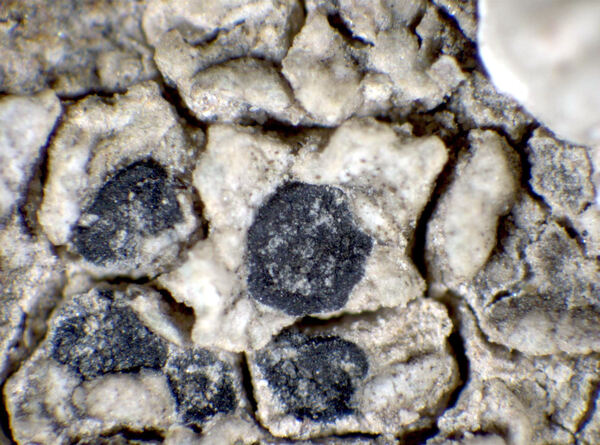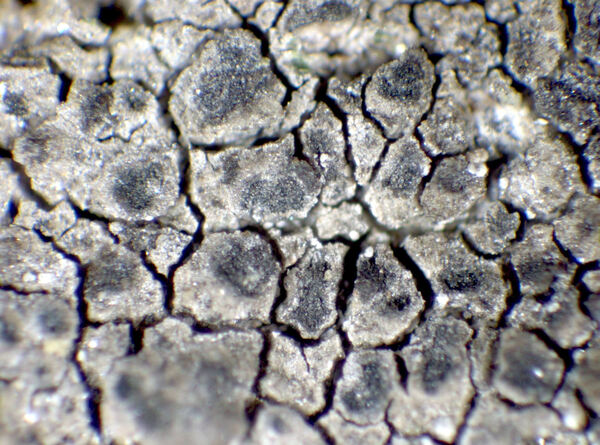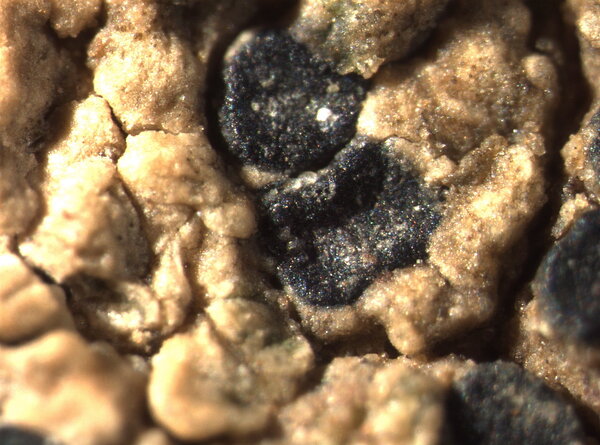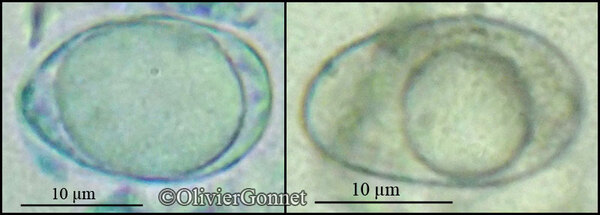Eiglera flavida (Hepp) Hafellner
Beih. Nova Hedwigia, 79: 276, 1984. Basionym: Lecanora flavida Hepp - Flecht. Eur.: nr. 630, 1860.
Synonyms: Aspicilia argillacea Anzi; Aspicilia flavida (Hepp) Rehm; Aspicilia micrantha Körb.; Aspicilia ochracea A. Massal.; Lecidea contraria Malme
Distribution: N - Frl (TSB 14176), Ven (Nimis 1994), TAA (Nascimbene & al. 2022), Lomb, Piem (Isocrono & al. 2004, Matteucci & al. 2013), VA (Matteucci & al. 2015c), Emil (Tretiach & al. 2008, Fariselli & al. 2020), Lig (Nascimbene & al. 2021). C - Tosc, Mol (Nimis & Tretiach 2004, Caporale & al. 2008). S - Si.
Description: Thallus crustose, thinly episubstratic, continuous to cracked, pale yellow-grey to pale brown, forming 1-2 cm wide patches, ecorticate or with a thin protocortex; medulla poorly evident, the whole thallus been filled with algal cells. Apothecia immersed, almost aspicilioid, circular in outline, up to 0.4 mm across, with a black, concave to flat disc, and a thin, not prominent proper margin. Proper exciple poorly developed, more or less paraplectenchymatous, formed from modified paraphysoids, colourless and very thin in lower part, greenish and thicker in upper part; epithecium blue-green, N+ purple-red to violet, K-; hymenium pale blue-green in upper part, colourless in lower part, 60-80 µm high, I+ dark blue; paraphyses coherent, simple or sparingly branched in upper part, 1-1.7 mm thick at mid-level, often slightly moniliform in upper part, the apical cells up to c. 3 µm wide; hypothecium colourless, c. 20 µm high. Asci 8-spored, broadly clavate, with a uniformly K/I+ blue tholus without an ocular chamber, surrounded by a thick, gelatinous, K/I+ blue sheath. Ascospores 1-celled, hyaline, broadly ellipsoid to ellipsoid, (12-)15-18(-23) x (7-)10-15(-17) µm. Pycnidia immersed, 0.03-0.05 mm wide, with a dark blue-green, N+ purple wall. Conidia short-cylindrical, 3-4 µm long. Photobiont chlorococcoid, the cells 7-12 µm wide (but cyanobacteria are often loosely associated with the thallus). Spot tests: thallus K-, C-, KC-, P-, UV-. Chemistry: without lichen substances.Note: a cool-temperate to arctic-alpine lichen found on base-rich or weakly calciferous rocks, often on pebbles and small stones near the ground in cold sites, with optimum near or above treeline; widespread throughout the Italian Alps and also known from the Apennines and the mountains of Sicily, but very much overlooked.
Growth form: Crustose
Substrata: rocks
Photobiont: green algae other than Trentepohlia
Reproductive strategy: mainly sexual
Commonnes-rarity: (info)
Alpine belt: rare
Subalpine belt: rather rare
Oromediterranean belt: extremely rare
Montane belt: extremely rare
Submediterranean belt: absent
Padanian area: absent
Humid submediterranean belt: absent
Humid mediterranean belt: absent
Dry mediterranean belt: absent
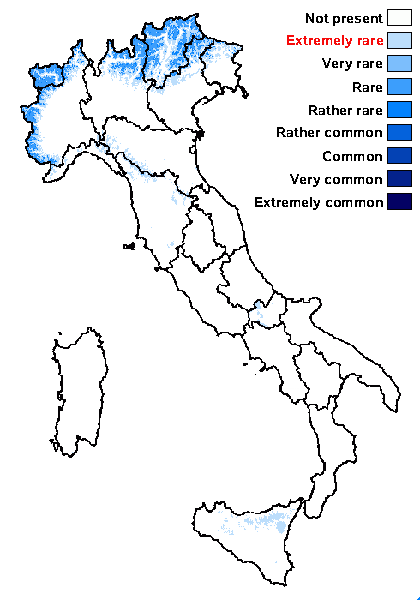
Predictive model
Herbarium samples
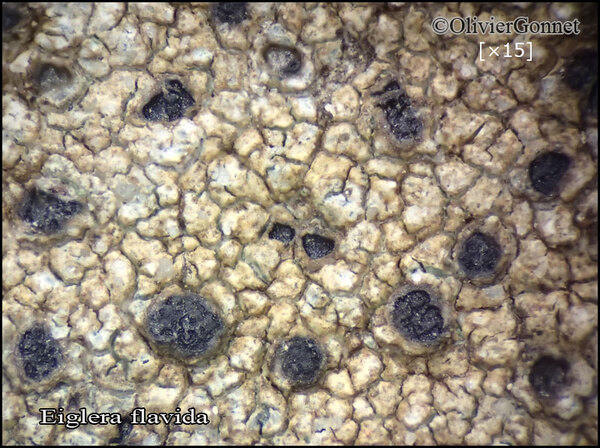
Courtesy Danièle et Olivier Gonnet - Source: https://www.afl-lichenologie.fr/Photos_AFL/Photos_AFL_E/Texte_E/Eiglera_flavida.htm
France, Villard-de-Lans - Isère - (38) - Saxicole, sur calcaire compact - Sentier sous le Col Vert, alt. 1650 m
19/09/2015
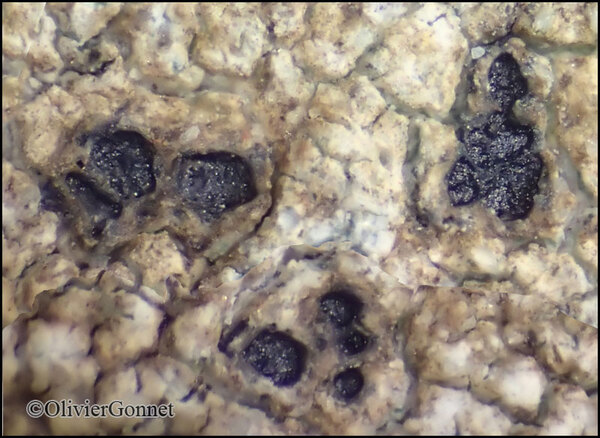
Courtesy Danièle et Olivier Gonnet - Source: https://www.afl-lichenologie.fr/Photos_AFL/Photos_AFL_E/Texte_E/Eiglera_flavida.htm
France, Villard-de-Lans - Isère - (38) - Saxicole, sur calcaire compact - Sentier sous le Col Vert, alt. 1650 m
19/09/2015
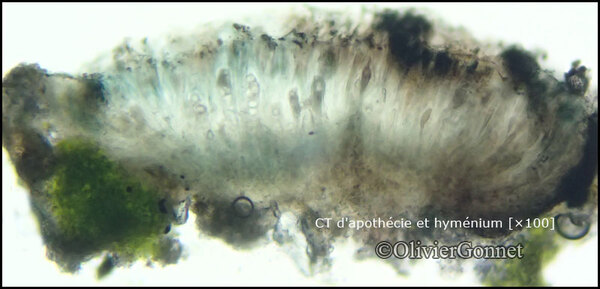
Courtesy Danièle et Olivier Gonnet - Source: https://www.afl-lichenologie.fr/Photos_AFL/Photos_AFL_E/Texte_E/Eiglera_flavida.htm
France, Villard-de-Lans - Isère - (38) - Saxicole, sur calcaire compact - Sentier sous le Col Vert, alt. 1650 m
19/09/2015
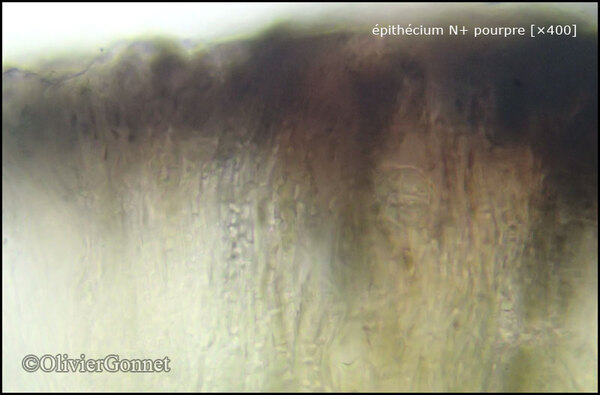
Courtesy Danièle et Olivier Gonnet - Source: https://www.afl-lichenologie.fr/Photos_AFL/Photos_AFL_E/Texte_E/Eiglera_flavida.htm
France, Villard-de-Lans - Isère - (38) - Saxicole, sur calcaire compact - Sentier sous le Col Vert, alt. 1650 m
19/09/2015
Growth form: Crustose
Substrata: rocks
Photobiont: green algae other than Trentepohlia
Reproductive strategy: mainly sexual
Commonnes-rarity: (info)
Alpine belt: rare
Subalpine belt: rather rare
Oromediterranean belt: extremely rare
Montane belt: extremely rare
Submediterranean belt: absent
Padanian area: absent
Humid submediterranean belt: absent
Humid mediterranean belt: absent
Dry mediterranean belt: absent

Predictive model
| Herbarium samples |

Courtesy Danièle et Olivier Gonnet - Source: https://www.afl-lichenologie.fr/Photos_AFL/Photos_AFL_E/Texte_E/Eiglera_flavida.htm
France, Villard-de-Lans - Isère - (38) - Saxicole, sur calcaire compact - Sentier sous le Col Vert, alt. 1650 m
19/09/2015

Courtesy Danièle et Olivier Gonnet - Source: https://www.afl-lichenologie.fr/Photos_AFL/Photos_AFL_E/Texte_E/Eiglera_flavida.htm
France, Villard-de-Lans - Isère - (38) - Saxicole, sur calcaire compact - Sentier sous le Col Vert, alt. 1650 m
19/09/2015

Courtesy Danièle et Olivier Gonnet - Source: https://www.afl-lichenologie.fr/Photos_AFL/Photos_AFL_E/Texte_E/Eiglera_flavida.htm
France, Villard-de-Lans - Isère - (38) - Saxicole, sur calcaire compact - Sentier sous le Col Vert, alt. 1650 m
19/09/2015

 INDEX FUNGORUM
INDEX FUNGORUM
 GBIF
GBIF
 DOLICHENS
DOLICHENS


